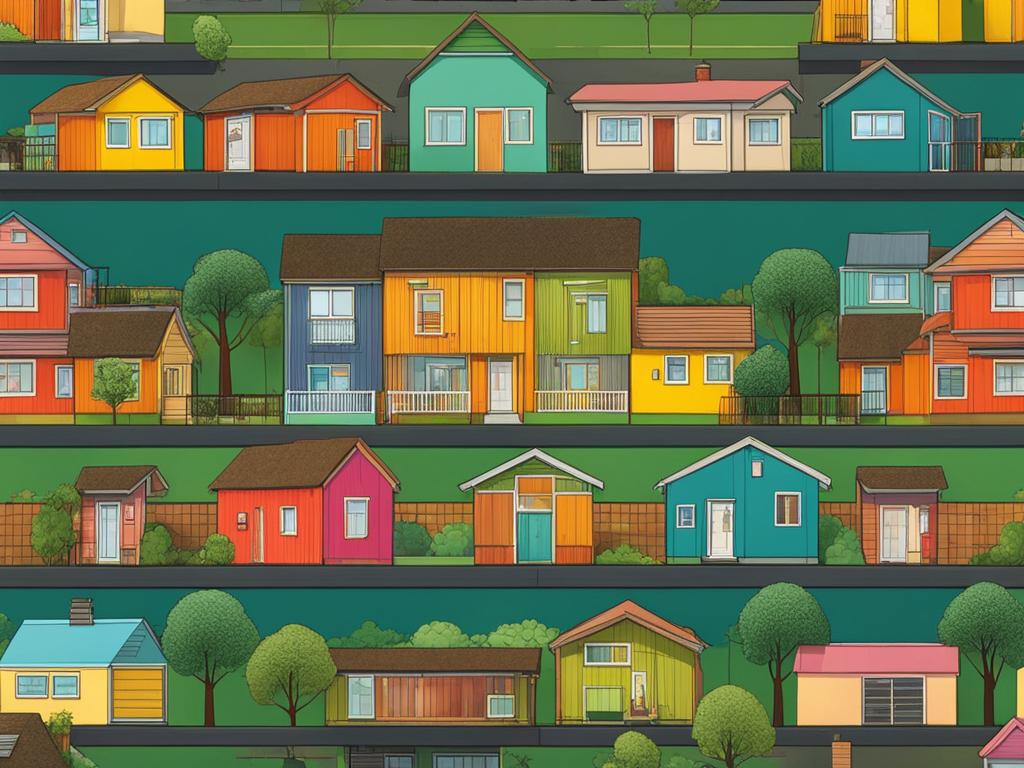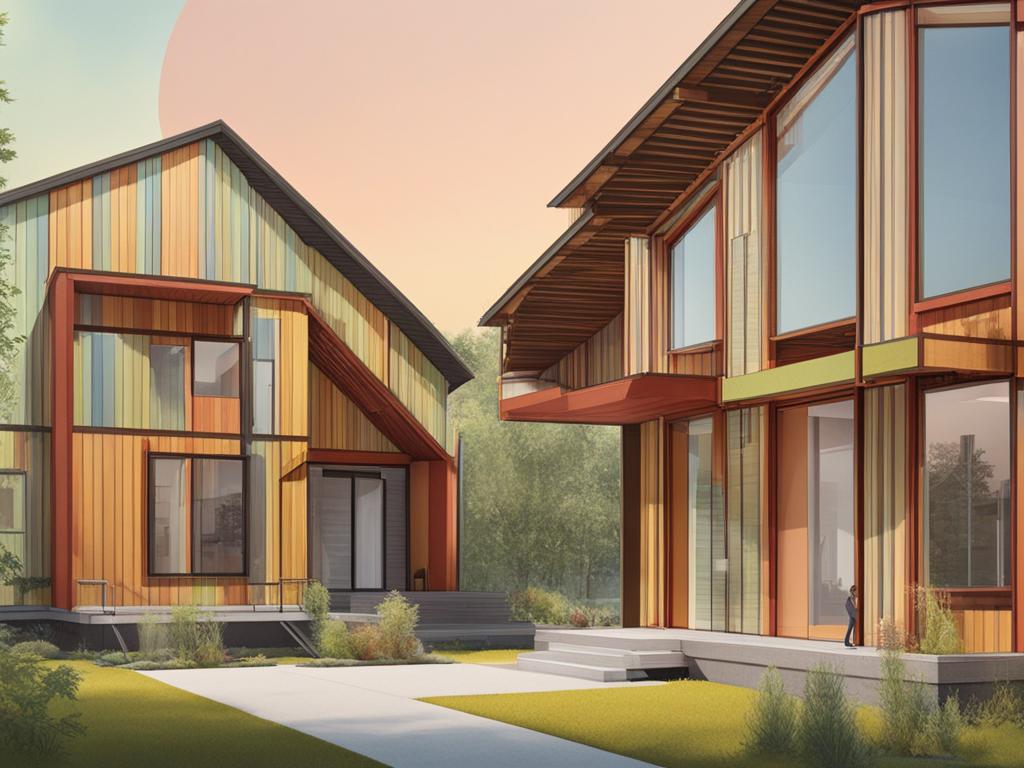Prefab construction is gaining traction around the world, with a significant percentage of houses in countries like Germany and Japan being prefabricated. In the United Kingdom, prefab construction is still at a relatively low percentage, but there are reasons to believe it will grow in popularity. Skilled labour shortages, faster construction times, and the desire for more sustainable and energy-efficient options are all factors contributing to the increasing interest in prefab houses.
Key Takeaways:
- There are various types of prefab houses available, offering different benefits and design options.
- Prefab construction can provide faster construction times and greater energy efficiency.
- Modular homes, panelized construction, timber-frame homes, and kit homes are some of the popular types of prefab houses.
- Prefab construction is expected to continue to expand in the United Kingdom and beyond as interest in sustainable housing grows.
- Choosing the right type of prefab house depends on individual preferences, budget, and desired design.
Modular Homes
Modular homes are one of the most complete types of prefab housing. They are built in sections or modules in a factory, which are then transported to the construction site and assembled on a foundation. Some modular homes arrive at the site almost complete, while others require additional work to finish.
Modular homes offer a faster construction time and can be more cost-effective in areas with high labour costs. They also provide design flexibility and can be customised to meet individual preferences. Whether you prefer traditional or contemporary styles, modular homes can be tailored to suit your needs.
One of the key benefits of modular homes is their efficient construction process. Because the modules are manufactured in a controlled factory environment, the construction is not delayed by weather conditions or other external factors. This results in faster project completion, saving time and money.

Panelized Construction
Panelized construction is an innovative method that involves assembling the exterior walls of a home off-site and then transporting them to the construction site. This approach offers numerous benefits and advantages, making it an attractive option for those looking to build their dream homes.
Panelized homes are built using pre-fabricated wall panels that are constructed in a factory-controlled environment. These panels are then transported to the site and installed, resulting in a faster and more efficient construction process. Some panelized homes even arrive at the site with windows and doors already installed, further expediting the building process.

One of the key advantages of panelized construction is the significant reduction in construction time. With the majority of the home’s exterior being pre-built, it eliminates the need for time-consuming on-site construction. This can be particularly beneficial for those who are working on tight schedules or wish to move into their new homes quickly.
Another noteworthy advantage is the energy efficiency that panelized homes can offer. The wall panels are typically manufactured with excellent insulation properties, ensuring that the home remains well-insulated and energy-efficient. This can lead to reduced energy consumption and lower utility bills over time.
Design flexibility is also a key feature of panelized construction. The panels can be customized to meet specific architectural requirements and preferences. Whether it’s adding unique design elements, incorporating eco-friendly features, or creating an open and spacious layout, panelized construction allows for greater design freedom compared to traditional construction methods.
Panelized homes offer a blend of quality craftsmanship, speed of construction, and customization options. Whether you’re looking to build a traditional family home, a contemporary masterpiece, or anything in between, panelized construction provides a viable solution to bring your vision to life.
Structural Insulated Panels (SIPs)
Structural Insulated Panels (SIPs) are a revolutionary construction technology that offers numerous benefits for homeowners. These panels consist of two oriented strand boards (OSB) with a foam core in between, creating a rigid and durable structure. SIPs are both structural and insulating, eliminating the need for traditional wood framing and providing exceptional energy efficiency.
One of the key advantages of SIPs is their quick and efficient assembly. The panels are pre-cut and ready to be installed, reducing construction time significantly compared to traditional building methods. This not only saves time but also lowers labor costs, making SIP construction an attractive option for homeowners.
Benefits of SIP Construction
- Energy Efficiency: SIPs offer excellent thermal performance, preventing heat loss in winter and maintaining coolness in summer. This energy efficiency reduces the reliance on heating and cooling systems, leading to lower utility bills.
- Design Flexibility: SIPs can be customized to suit various architectural styles and designs. They can accommodate open floor layouts, allowing for spacious and modern interior designs. With fewer interior walls needed, SIP-constructed homes provide the flexibility to create unique living spaces.
- Structural Strength: The foam core in SIPs provides exceptional structural strength. This makes SIP-constructed homes resilient to extreme weather conditions and resistant to pests and mold.
- Environmentally Friendly: SIP construction reduces waste compared to traditional wood framing. The use of sustainable materials, such as OSB and foam insulation, contributes to a more eco-friendly building method.
Whether you’re looking to build a new home or renovate an existing one, SIP construction offers numerous advantages. From the efficient assembly process to the energy savings and design flexibility, SIPs are a smart choice for homeowners who prioritize comfort, sustainability, and cost-effectiveness.

Kit Homes
Kit homes offer an exciting and cost-effective solution for individuals looking to build their own homes. These prefab kit homes are pre-designed and constructed off-site, ensuring a streamlined building process. Available in flat-pack form, kit homes can be customized to suit individual preferences, allowing homeowners to create a space that reflects their unique style and needs.
One of the main advantages of kit homes is their popularity among self-builders. With comprehensive assembly instructions and all necessary materials included, individuals can take on the challenge of building their own homes with confidence. This hands-on approach not only provides a sense of accomplishment but also allows for greater cost control.
Kit homes come with various design options, allowing homeowners to choose a style that aligns with their vision. Whether it’s a modern, minimalist design or a traditional, country-inspired home, kit homes can be tailored to match specific aesthetic preferences.

The benefits of kit homes extend beyond customizability and affordability. The prefab nature of these homes ensures faster construction times when compared to traditional construction. Moreover, the controlled environment of the factory eliminates weather-related delays, making them an ideal option for projects in areas with unpredictable climates.
Kit homes also offer the advantage of environmental sustainability. With a focus on energy efficiency, these homes are designed to minimize waste and maximize resource usage. The insulation and construction materials used in kit homes contribute to a reduced carbon footprint and lower energy costs.
Overall, kit homes provide an attractive and versatile option for aspiring homeowners. With their affordability, customization options, efficient construction process, and environmental benefits, kit homes are revolutionizing the self-build market. Whether you’re a first-time homeowner or an experienced builder, exploring kit homes as a housing solution is definitely worth considering.
Timber-Frame Homes
Timber-frame homes offer a perfect combination of traditional construction methods and the benefits of prefab construction. These homes are built using pre-cut wooden frames that are assembled on-site with precision and expertise. One of the key advantages of timber-frame construction is its design flexibility, allowing homeowners to create unique architectural features and customize their homes to their exact preferences.
With timber-frame homes, it is also possible to incorporate walls made from Structural Insulated Panels (SIPs) to enhance insulation and increase energy efficiency. SIP walls provide excellent thermal performance, reducing energy consumption and keeping homes comfortable throughout the year.
Timber-frame construction is highly versatile, making it suitable for various architectural styles and designs. Whether you prefer a contemporary, traditional, or rustic look, timber-frame homes can be tailored to match your desired aesthetic.
Not only do timber-frame homes offer exceptional design possibilities, but they also provide numerous benefits for homeowners. The use of timber as a construction material is both sustainable and renewable, contributing to a greener environment.
Furthermore, timber-frame construction allows for a faster and more efficient building process, reducing construction time and labor costs. The pre-cut frames simplify the assembly process, ensuring a quicker turnaround without compromising the structural integrity of the home.

Other Types of Prefab Construction
Aside from the previously mentioned prefab construction methods, there are other exciting options available for those seeking alternative housing solutions. These include prefab log homes, prefab steel frame homes, prefab container homes, and prefab concrete homes.
Prefab log homes embrace the rustic charm of log cabins while offering the convenience and efficiency of prefab construction. These homes boast natural beauty, warmth, and durability, making them an excellent choice for nature lovers and those seeking a cozy, traditional-style retreat.
Prefab steel frame homes provide a modern and sleek aesthetic while maintaining structural strength and durability. Their steel frames offer exceptional resistance to mold, pests, and fire, making them a secure and low-maintenance housing option. With versatile design possibilities, they can easily be customized to suit individual preferences.
Prefab container homes utilize recycled shipping containers as building blocks, resulting in eco-friendly and sustainable housing solutions. These homes offer affordability, portability, and the ability to repurpose materials, making them an excellent choice for those who appreciate unique and environmentally-conscious designs.
Prefab concrete homes leverage the strength and durability of concrete materials. These homes offer excellent insulation properties, energy efficiency, and resistance to natural disasters. With their robust construction, prefab concrete homes provide longevity and stability for homeowners.
Each of these prefab construction methods presents its own unique characteristics and benefits. From the charm of log homes to the modern appeal of steel frames and the sustainable nature of container and concrete homes, there is a prefab construction option to suit diverse preferences and needs.
Conclusion
Prefab construction provides a wide range of options for individuals looking to build a new home in the UK. Whether it’s modular or panelized construction, timber-frame or kit homes, each type offers unique advantages. One of the key benefits of prefab houses is the faster construction time, allowing homeowners to move in more quickly and enjoy their new space sooner. Additionally, prefab homes are known for their energy efficiency, helping to reduce utility bills and minimize environmental impact. The design flexibility of prefab construction allows homeowners to customize their homes to suit their specific preferences and lifestyles.
As the demand for sustainable and eco-friendly housing solutions continues to grow, the prefab housing market in the UK is expected to expand even further. With a focus on efficient construction methods and the use of environmentally friendly materials, prefab homes offer an attractive option for those who want to minimize their carbon footprint without compromising on quality or style.
Whether you’re looking for a modern modular home, a traditional timber-frame house, or a stylish kit home, the options for prefab construction in the UK are vast. Embracing the benefits of prefab houses means enjoying shorter construction times, lower energy costs, and the ability to create a home that truly reflects your individual taste and needs. With all these advantages, it’s no wonder that prefab construction is becoming an increasingly popular choice for homeowners in the UK.
FAQ
What are the different types of prefab houses?
The different types of prefab houses include modular homes, panelized construction, structural insulated panels (SIPs), kit homes, timber-frame homes, and other options such as prefab log homes, prefab steel frame homes, prefab container homes, and prefab concrete homes.
What are modular homes?
Modular homes are built in sections or modules in a factory and then transported to the construction site to be assembled on a foundation. They offer faster construction time, design flexibility, and can be customized to individual preferences.
What is panelized construction?
Panelized construction involves assembling the exterior walls of a home off-site and then transporting them to the construction site for installation. It offers faster installation times, energy efficiency, and design flexibility.
What are structural insulated panels (SIPs)?
Structural insulated panels (SIPs) are panels made up of two oriented strand boards (OSB) with a foam core in between. They provide insulation and structural support, resulting in faster construction times and energy-efficient homes with open interior spaces.
What are kit homes?
Kit homes are pre-designed and prefabricated off-site. They come in flat-pack form and can be customized to individual preferences. Kit homes are popular among self-builders and offer a cost-effective solution for those looking to build their own home.
What are timber-frame homes?
Timber-frame homes are constructed with pre-cut wooden frames that are assembled on-site. They offer design flexibility and can incorporate structural insulated panels (SIPs) for enhanced insulation and energy efficiency.
What other types of prefab construction are available?
Other types of prefab construction include prefab log homes, prefab steel frame homes, prefab container homes, and prefab concrete homes. Each method offers various benefits, including sustainability, durability, and design possibilities.
Why choose prefab houses?
Prefab houses offer faster construction times, energy efficiency, design flexibility, and the ability to customize to individual preferences. With the growing interest in sustainable and eco-friendly housing, prefab construction is becoming more popular.
Are prefab homes popular in the UK?
Prefab homes are gaining popularity in the UK as they offer a range of benefits. With the increasing interest in sustainable and energy-efficient housing solutions, the prefab housing market is expected to continue expanding in the UK and beyond.




